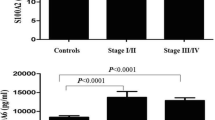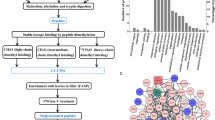Abstract
The involvement of alarmin high-mobility group nucleosome-binding protein 1 (HMGN1) in non-small cell lung cancer (NSCLC) is unknown. To address the presence of HMGN1 in the serum of different stages of NSCLC patients and healthy controls, we enrolled a consecutive sample of adult serum at diagnosis and correlated it with clinicopathologic outcomes. A total of 100 NSCLC patients and 23 healthy volunteers were enrolled from January 2012 through December 2013. Serum HMGN1 levels were determined by enzyme-linked immunosorbent assay (ELISA). Additionally, HMGN1 levels in 50 NSCLC patients with early-stage disease who received curative pneumonectomy were correlated with survivals. Kaplan-Meier plots were used to analyze the data. The patients with NSCLC were characterized by significantly higher serum levels of HMGN1 (0.4585 ± 0.0640 ng/ml) compared to those in healthy controls (0.3578 ± 0.0304 ng/ml). The serum HMGN1 levels were 0.4027 ± 0.0271 ng/ml, 0.4604 ± 0.0328 ng/ml, 0.5408 ± 0.0459 ng/ml, and 0.4213 ± 0.0341 ng/ml in patients with TNM stages I, II, IV, and IV, respectively (p < 0.001). There were significant differences among four groups (p < 0.001). Additionally, a positive correlation between serum HMGN1 and tumor stage was found in local disease, while serum HMGN1 level in metastatic NSCLC patients was significantly decreased. The Kaplan-Meier plots showed that patients with high serum HMGN1 had a poorer overall survival (OS) after curative pneumonectomy than those with low serum HMGN1 (p = 0.019). Inflammation triggered by alarmins plays a role in NSCLC pathogenesis. HMGN1 can serve as a useful clinical parameter for evaluating disease progression and predicting the outcomes for early-stage patients with NSCLC undergoing pneumonectomy.




Similar content being viewed by others
References
Siegel RL, Miller KD, Jemal A. Cancer statistics, 2015. CA Cancer J Clin. 2015;65(1):5–29.
Bianchi ME, Agresti A. HMG proteins: dynamic players in gene regulation and differentiation. Curr Opin Genet Dev. 2005;15(5):496–506.
Bustin M. Regulation of DNA-dependent activities by the functional motifs of the high-mobility-group chromosomal proteins. Mol Cell Biol. 1999;19(8):5237–46.
Birger Y et al. Increased tumorigenicity and sensitivity to ionizing radiation upon loss of chromosomal protein HMGN1. Cancer Res. 2005;65(15):6711–8.
Birger Y et al. Chromosomal protein HMGN1 enhances the rate of DNA repair in chromatin. EMBO J. 2003;22(7):1665–75.
Yang D et al. High-mobility group nucleosome-binding protein 1 acts as an alarmin and is critical for lipopolysaccharide-induced immune responses. J Exp Med. 2012;209(1):157–71.
Wei F et al. The Alarmin HMGN1 contributes to antitumor immunity and is a potent immunoadjuvant. Cancer Res. 2014;74(21):5989–98.
Mange A et al. Serum autoantibody signature of ductal carcinoma in situ progression to invasive breast cancer. Clin Cancer Res. 2012;18(7):1992–2000.
Uramoto H, Tanaka F. Recurrence after surgery in patients with NSCLC. Transl Lung Cancer Res. 2014;3(4):242–9.
Coffelt SB, Scandurro AB. Tumors sound the alarmin(s). Cancer Res. 2008;68(16):6482–5.
Ellerman JE et al. Masquerader: high mobility group box-1 and cancer. Clin Cancer Res. 2007;13(10):2836–48.
Sims GP et al. HMGB1 and RAGE in inflammation and cancer. Annu Rev Immunol. 2010;28:367–88.
Tang D et al. High-mobility group box 1 and cancer. Biochim Biophys Acta. 2010;1799(1-2):131–40.
Li Y et al. Serum high mobility group box protein 1 as aclinical marker for ovarian cancer. Neoplasma. 2014;61(5):579–84.
Shang GH et al. Serum high mobility group box protein 1 as a clinical marker for non-small cell lung cancer. Respir Med. 2009;103(12):1949–53.
Wang JL et al. Expression of high mobility group box - B1 (HMGB-1) and matrix metalloproteinase-9 (MMP-9) in non-small cell lung cancer (NSCLC). Asian Pac J Cancer Prev. 2014;15(12):4865–9.
Zhang C et al. MiRNA-218, a new regulator of HMGB1, suppresses cell migration and invasion in non-small cell lung cancer. Acta Biochim Biophys Sin. 2013;45(12):1055–61.
Zhang X, Wang H, Wang J. Expression of HMGB1 and NF-kappaB p65 and its significance in non-small cell lung cancer. Contemp Oncol. 2013;17(4):350–5.
Kang R et al. HMGB1 in health and disease. Mol Asp Med. 2014;40C:1–116.
Yang D et al. The alarmin functions of high-mobility group proteins. Biochim Biophys Acta. 2010;1799(1-2):157–63.
Acknowledgments
This work has been funded, in part, by grants from the National Natural Science Foundation of China (No. 30901376) and Tianjin Application Foundation and Advanced Technology Research Program (No. 13JCYBJC41400, No. 14JCTPJC00476).
Conflicts of interest
None
Ethical approval
All procedures performed in studies involving human participants were in accordance with the ethical standards of the institutional and/or national research committee and with the 1964 Helsinki Declaration and its later amendments or comparable ethical standards.
Author information
Authors and Affiliations
Corresponding author
Additional information
Feng Wei and Fan Yang contribute equally as first authors.
Rights and permissions
About this article
Cite this article
Wei, F., Yang, F., Jiang, X. et al. High-mobility group nucleosome-binding protein 1 is a novel clinical biomarker in non-small cell lung cancer. Tumor Biol. 36, 9405–9410 (2015). https://doi.org/10.1007/s13277-015-3693-7
Received:
Accepted:
Published:
Issue Date:
DOI: https://doi.org/10.1007/s13277-015-3693-7




